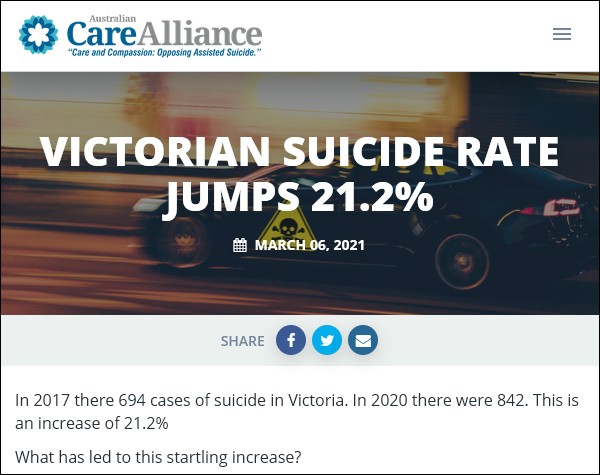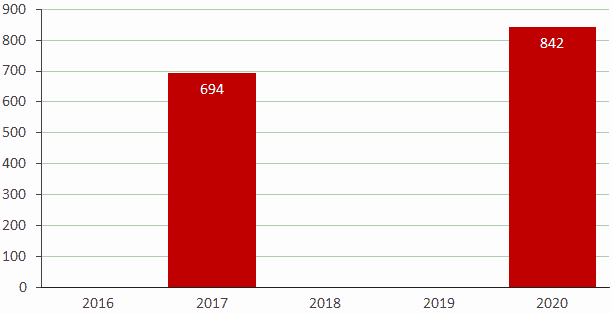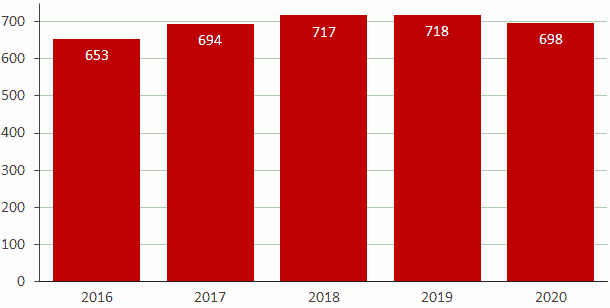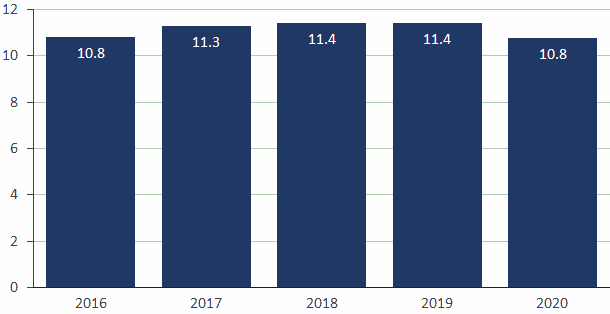Anti-VAD suicide gaffes a major embarrassment

Here we go again. Branka van der Linden of Catholic anti-VAD website “HOPE”, and the Australian Care Alliance — endorsed by a number of well-known, committed Catholic doctors — have just published more egregious misinformation against VAD. This time they've collectively piled it on Victoria's general suicide statistics, recently updated by the Victorian Coroner. So what did they say, and how did it misrepresent the actual situation? Let's take a look.
The reason the statistics are being discussed is because in 2017, Victoria's parliament legalised voluntary assisted dying (VAD) for the terminally ill. The law came into effect halfway through 2019, and 2020 was the first full year of its operation.
Australian Care Alliance gets the basics wrong
Here's the Australian Care Alliance's (ACA) splashy page trumpeting that Victoria's suicide rate has jumped 21.2% from 694 in 2017 to 842 in 2020.
 Figure 1: ACA's splashy page trumpeting a 21.2% increase in Victorian suicides
Figure 1: ACA's splashy page trumpeting a 21.2% increase in Victorian suicides
That's... interesting. According to the Victorian coroner's official figures, there were indeed 694 suicides in Victoria in 2017. However, in 2020 the coroner's figure is actually 698, not 842 as claimed by the ACA. According to the ACA, Victoria's suicide count data looks like this (Figure 2).
 Figure 2: The ACA polemically claims that Victoria's suicide count has increased 21.2%
Figure 2: The ACA polemically claims that Victoria's suicide count has increased 21.2%
So, how did the ACA reach a count of 842? Well, their argument is to shamefully and humiliatingly disrespect Victoria's terminally ill who died peacefully under its VAD law in 2020 — 144 of them according to the official 2020 reports of Victoria's Voluntary Assisted Dying Review Board — and add them to the coronial count of 698 suicides.
The ACA points out that VAD supporters have said that legalising VAD should decrease Victoria's general suicides by about 50 cases a year, but say the count's gone up substantially instead. See how they craftily deploy logical fallacy to fabricate a crisis?
Arguing that VAD law must reduce the suicide count by 50 cases a year (but seemingly didn't) and at the same time adding VAD cases to the suicide count to complain that it's gone up, requires at least three assumptions:
- that all terminally ill violent suiciders now automatically qualify for and easily gain access to VAD; and
- that nobody else with a terminal illness who would not have chosen violent suicide, should or would use the law; and
- that no other factors make a significant difference to trends in general suicides.
All these assumptions are patently false.
Obviously, some people will not legally qualify for VAD; for example, amongst its restrictions it requires death to be expected with 6 months; 12 months for a small set of specific illnesses.
Obviously, some who would not have suicided but instead would suffer intolerably and against their wishes until death, will now choose to pursue VAD.
And obviously, well-known factors such as rates of mental illness, substance abuse, intimate relationship troubles, bullying, financial or legal difficulties, and other factors are major influencers of general suicide rates. But to the ACA, the only factor that supposedly has any effect is the one they are ideologically opposed to: VAD.
It's worrisome that this nonsense is sold to the public by ACA's supposed experts: “health professionals and lawyers”.
Cherry-picked overseas data, too
The ACA's ideological bias is further revealed by their website page about the “social contagion of suicide”. In it, they cite as authoritative, the 2015 Jones and Paton (both firm Catholics) article purporting to show 6.3% suicide contagion from VAD to the general population. I've comprehensively exposed that article as an ideologically-driven mathematical farce fuelled by no fewer than ten major scientific offenses. It's interesting that the ACAs methodology is just like Jones' and Patons': reporting VAD supporter statements that legalisation should decrease the general suicide rate, and then adding VAD deaths to conclude the opposite.
They also commit one of Jones' and Patons' other offences: selectively quoting data from other studies that might be seen to support their theory, but excluding critical alternative information from the same study that runs counter to the theory.
The ACA cites a Swiss study to breathlessly report that 6.5% of those who witnessed an assisted death in that country experienced sub-threshold PTSD, and 13% full PTSD. The ACA expressly states:
“Like any other suicide, assisted suicide can profoundly affect surviving family members and friends.” — The Australian Care Alliance
There you have it: the ACA draws a direct equivalence between peaceful VAD deaths in the face of terminal illness and with loved ones present, and lonely, violent deaths by general suicide.
The ACA cites no other relevant material from the Swiss article. That's revealing, because the article clearly reported that the PTSD rates were higher than in the general population. There's what the ACA left out: the PTSD rates were higher than for almost everyone else who hadn't just suffered the loss of a loved one.
To draw valid and meaningful interpretations, it is necessary to compare the bereavement challenges of VAD family versus families of general deaths, deaths in the face of extreme suffering without hastened death, and cases of violent suicide. As I've published before from peer-reviewed studies, bereavement symptoms of VAD family are at least as good as, and can be better than those where the deceased has suffered in extremis at the end of life, and certainly relative to violent suicides.
The ACA also doesn't mention that the Swiss study found a "prevalence of complicated grief ... comparable to that reported for the general Swiss population". It's not like the information was hard to find. It's right there in the Abstract on the front page of the article.
That the ACA cherry-picked a couple of Swiss data points while omitting key “unhelpful” information, and argued, by linking the selected cherries with the above quote, that said Swiss data established something it clearly did not (that VAD deaths supposedly cause similar family trauma as violent suicides), suggests an astonishing degree of ignorance.
The ACA's cherry-picking of data, while omitting key unhelpful information, suggests an astonishing degree of ignorance.
Enough of that.
Branka van der Linden cherry-picks, too
I've crossed pens (or is that keyboards?) with Ms van der Linden several times before in regard to misinformation. She misinforms on this matter, too.
Curiously, like the ACA and also without explanation, she cherry-picks just the 2017 and 2020 suicide counts from the Victorian coroner's report (Figure 3). You'd think this was the only data in the report, but no, it isn't.
 Figure 3: Branca van der Linden's version of Victorian suicide counts by year
Figure 3: Branca van der Linden's version of Victorian suicide counts by year
She uses these two figures to argue that said drop of 50 cases per year hasn't happened. This employs the same fallacies as the ACA: suggesting that two single data points strongly support a hypothesis, and assuming that the thing one is ideologically opposed to, VAD, is the only thing to alter the rate of general suicides over time.
Like the ACA, she also suggests adding the VAD figures to the coroner's general suicide data to say that in that case, suicides have increased significantly.
Both the Australian Care Alliance and Branca van der Linden cherry-pick just two data points from more full and robust longitudinal data to try and argue their case against VAD.
So what does the coroner's full data set look like?
The actual numbers
The Victorian coroner's 2021 report into suicides contains data for all years 2016 to 2020 inclusive. And it looks like this (Figure 4).
 Figure 4: The complete set of data from the Victorian coroner's report on suicide counts per year
Figure 4: The complete set of data from the Victorian coroner's report on suicide counts per year
Now we're beginning to see a possible reason as to why the ACA and Ms van der Linden chose just two data points. Remember that VAD was legalised by the Victorian parliament in 2017. The law was not in effect for 2017, 2018, or the first half of 2019.
Well, the data clearly suggests an increasing suicide count trend up to 2018. The upward trend stops in 2019, when VAD was in operation for the second half of the year. And in 2020, the first full operational year of VAD, the upward trend has been interrupted by a downward result. Neither the ACL nor Ms van der Linden mention this.
Neither the Australian Care Alliance nor Branca van der Linden mention the fuller, longitudinal data that doesn't support, and indeed appears hostile to, their hypothesis.
Update 19-Mar-2021
I thought it so obvious that I didn't write it up, but a colleague points out it's important to highlight, that in picking just two data points to stake their claim, the ACA and Ms van der Linden chose 2017, and not 2018, as their reference year. To compare “after” with “before” in the most basicly valid manner (full longitudinal data is better), it is appropriate to compare the last data point that completely excludes the new condition (VAD law in operation), with the first data point that fully includes it.
Those years are 2018 (none of the year) and 2020 (all of the year). But the ACA and Ms van der Linden didn't pick 2018, they picked 2017.
What possible reason might explain that? Well, by comparing 2017 with 2020, they got to say that the general suicide count increased by 2 from 694 to 698. However, had they more validly compared 2018 with 2020, they would have had to report a drop of 19 from 717 to 698.
And that would have contradicted their flimsy confection that suicides hadn't gone down after VAD was introduced.
But even the raw suicide count statistics are a bit misleading.
Interpreting suicide data correctly
Using raw counts to compare suicide statistics (e.g. year to year or place to place) is lazy and wrong. All other things being equal, if you had twice the population, you'd expect twice the suicide count. To make valid comparisons, you have to compare rates, not raw counts. This is relevant because populations obviously change over time, and Victoria between 2016 and 2020 was no exception.
I've retrieved the official Victorian population figures by year and computed the standard official suicide rate statistic: suicides per 100,000 population. The Victorian suicide rates look like this (Figure 5):
 Figure 5: Victorian suicides per 100k population by year
Figure 5: Victorian suicides per 100k population by year
The data shows a rising suicide rate from 2016 to 2018, a levelling off in 2019 in which VAD was operational for half the year, and a fall back to the 2016 rate in 2020, the first full operational year of VAD.
Computing from the rate drop between 2018 (11.4 with no VAD law) and 2020 (10.8, first full year of VAD law), the equivalent count of suicide decrease in 2020 was 38 persons. And that's without assuming the general suicide rate would have continued its rising trend.
The equivalent suicide decrease from 2018 to 2020 was 38 persons.
Getting all the numbers right
The ACA correctly cites then Minister for Health, Ms Jill Hennessy, as stating in 2017 that "Evidence from the coroner indicated that one terminally ill Victorian was taking their life each week." That would be 52 cases a year, which the ACA rounds out to 50 a year. The headline figure from the coroner's report actually calculates to 48. No biggie, just round numbers.
But the figure is quite wrong. You have to read the coroner's special 2017 report to the Victorian parliament regarding suicides in cases of illness, to calculate the correct numbers.
The coroner's report didn't just include suicide data for terminally ill people. It also included cases of advanced incurable but not terminal illness, and cases of severe suffering resulting from injuries. So the terminal illness data (to which the VAD law is relevant) is a fraction of the total. We can calculate from the Tables in the report that 23% of the cases were in respect of injuries, so that leaves 77% for terminal and other advanced illnesses.
Of the illnesses listed, the relevant one as a proxy measure for terminal illness is “cancer”, and that comprises 50% of the illness cases. So, 50% of 77% of 48 cases a year = 19 cases a year in respect of terminal illness.
So that's an actual likely decrease of 19 suicide cases a year, compared with an equivalent drop in the actual data of 38 persons in the first full year.
The actual annual count of general suicides in respect of terminal illness, as reported to the Victorian parliament by the state coroner in 2017, was 19 persons a year, and not 50 as widely stated.
Don't get carried away
It's imporant to note that citing this interesting numeric analysis as “proof” of the law's effectiveness in respect of reducing Victoria's suicide rate, would, at present, be an overconfident claim. While far more firmly based in proper forms of evidence than the vapid nonsense promoted by the ACA and Ms van der Linden, this is a correlation. Correlation does not equal causation: the ACA and Ms van der Linden should remember that. For example, 2020 was a very unusual, Covid-19-dominated annus horribilis, which may have affected suicide rates in unexpected ways.
While the coroner's fuller data set so far is consistent with reasoned expectations of suicide substitution, it is premature to conclude the data proves the principle. More years' data, and more detailed, causative analysis involving the control of confounding factors, is necessary before reaching greater certainty in the association.
But as I've published in detailed and extensive analyses based on robust official data, so far all the longitudinal data on suicide rates in jurisdictions where VAD is lawful is consistent with suicide substitution, not suicide contagion. Some VAD opponents just cherry-pick their way through tidbits to try and argue the opposite.
To date, all the robust, longitudinal data on suicides in jurisdictions where VAD is lawful is consistent with suicide substitution, not suicide contagion.
Conclusion
The Australian Care Alliance and Ms van der Linden disgracefully cherry-pick and misrepresent Victoria's recent suicide data in a manner consistent with their own theories, while proper and appropriate analysis of the full data available shows results inconsistent with their hypothesis, and currently consistent with the opposite.
To paraphrase Ms van der Linden's own statement: “It is unfortunate that the deaths of terminally ill Victorians were politicised so shamelessly by [anti-]euthanasia activists for their own ends.”
These continued cherry-picked data gaffes are an embarrassment to their promoters.
